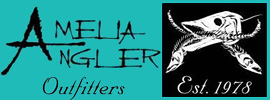Redfish prey on baitfish passing by key ambush points during a high falling tide where plugging with surface plugs requires several angling
skills.
A high falling tide gathered baitfish at key ambush points at the headwaters of Amelia Island’s “Langsford Creek”. Past fishing experiences had taught my son Terry David Lacoss and me that we needed to be here in this very exact spot, armed with surface plugs, where topwater red fishing just doesn’t get any better.
Terry David positioned our shallow water boat down current of a marsh island, jutting perfectly out into the deeper portion of the flooded mud flat. Redfish would soon be schooling behind the marsh point, waiting for mullet, crabs and shrimp to pass by within their strike zone.
Now the time was right as the flood tide began to fall, begging T.D. and me to cast our Mirror Lure “Top Dog” surface plugs, breath taken close to the marsh point. Here it was extremely critical to make your cast into the current and then work your topwater plug slowly into the eddying water where redfish would get a good, slow look.
Finally the head of a 7-lb redfish rose up behind Terry David’s topwater plug and crashed down on the mullet imitator. Terry David dropped his rod tip allowing the bay red to take the plug deep into its mouth, then reared back on his stout redfish rod. During a desperate run, Mr. Red was able to straighten the saltwater treble hook, and then retreat back into the deep pocket of marsh grasses.
Terry David’s following cast landed a ½ ounce gold spoon into the same pocket of flooded grass. The big red was fooled once again, but this time unable to straighten the strong spoon hook!
This same scenario played out in a CoCodrie Louisiana duck pond when a high falling tide found mullet schooling at the mouth of a major creek that fed the duck pond. The minute the tide began falling, it was like a light switch had been turned on and Louisiana reds began bombing our surface plugs!
Doesn’t matter what part of Florida, or the country for that matter, you have to try topwater red fishing during a high, falling tide.
Bait fishes begin migrating out from flooded marshes, creeks and the backsides of bays during the high falling tide. Take a closer look and you will soon identify nearby ambush points where baitfish schools begin to use as a migration highway.
Positioning your shallow water skiff down tide from the ambush point will allow you to work surface plugs right in the face of redfish that are holding on the ambush point. Redfish will in many cases swim into the current and wait in ambush either at the face of the ambush point, or just behind the ambush point where there is an eddy.
You will certainly get more strikes and hook more reds when choosing 20-pound monofilament fishing line. Regular monofilament fishing lines float, where fluorocarbon fishing lines will sink making them difficult when working surface lures properly. Sinking fishing lines will also spook redfish, particularly in clear water conditions. Regular mono lines will also stretch, which allows redfish to take the surface plug deep in their mouth, verses fluorocarbon and braided fishing lines that have very little stretch.
However in cases where submerged oyster bars, barnacle clad pilings, or mangrove roots, tend to cut off your mono fishing line, tying 20-pound braid directly to your surface plug will save your plug and keep your redfish hooked up.
Making a loop knot connection to your topwater plug will also impart a better swimming action to your surface plug.
Many red fishermen including myself prefer a six and a half foot casting rod with a medium light tip for casting accuracy and a medium heavy butt section for working big reds away from structure. A casting rod and reel setup will also afford for more accurate casts than spin tackle, however spinning gear should be a consideration on windy days.
“Keep your surface plug in the strike zone”!
Keeping your surface plug working slowly in the redfish’s ambush point is key. Chugger type surface plugs can be chugged hard, and then allowed to rest for a long two - three count before a second chug is imparted. Cigar shaped plugs can also be worked super slow by walking the plug to the side, then allowing it to sit, before it walks to the opposite direction. While in many cases, reds will simply blow up on a surface lure and miss the hooks. Replacing the rear treble hook with a new VMC “Sure Set” treble hook will make that redfish connection more often. Here the top hook is a wide gap type hook that actually reaches out to hook your redfish.
The best time of year for taking reds with top water plugs, is by far the fall time of year when a major mullet run is taking place. Couple this with a fall shrimp spawn and you have the best time of year for redfish on top! When a major shrimp hatch is taking place, surface chuggers work best. When mullet are schooling, cigar shaped surface plugs become more effective. Some of the better color patterns include mullet patters, when baitfish are schooling, chartreuse for dirty water conditions and gold or black for overcast days.








